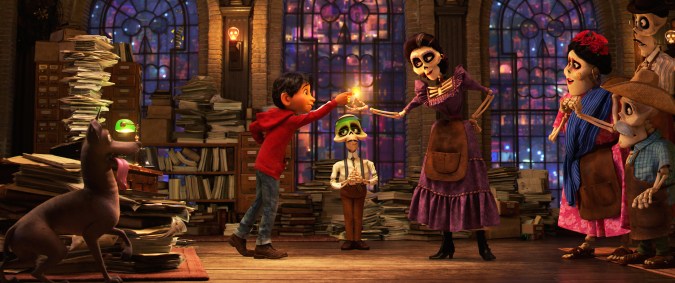When Adrian Molina had his car all packed up to for college, his parents stopped him. There was one thing they had to give him before he set off on this new adventure at California Institute of the Arts: their blessing. “Guide our son,” they told him, “and help him achieve all he wants to achieve and let him know that we love him.” The gesture surprised the young would-be storyboard artist for the way it tapped into his family’s Mexican heritage. So touched was he by that moment which connected family and culture alike that he turned to it while working at the story department for the Día de Muertos-themed film, Coco. Having been at Pixar for years (working on such hits as Toy Story 3, Ratatouille, Monsters University and The Good Dinosaur) Molina found himself excavating his own experience in trying to tackle the story challenges that the Lee Unkrich-directed project set in Mexico was facing in its development. The result? He ended up becoming the film’s writer and co-director.
Anyone familiar with Coco’s plot knows how central Molina’s “blessing” moment became. When young Miguel Rivera (played by Anthony Gonzalez) ends up in the Land of the Dead, it is his family’s blessing that will send him back to the Land of the Living. As Molina explained to Remezcla during our recent trip to Oaxaca to visit some of the inspirations behind the film, to make Miguel need that approval from his ancestors (granted with the use of the iconic marigold petals) was a perfect way to help mirror what he’d been craving in the film’s first act. While his abuelita and parents want the musically inclined boy to follow in his family’s footsteps and take up shoemaking, Miguel wants nothing more than to have them accept his desire to play the guitar like his role model, Ernesto de la Cruz. Pursuing that dream (by stealing de la Cruz’s guitar) is what lands Miguel in the skeleton-filled world of the dead in the first place. There, he even refuses his great-great-grandmother Mama Imelda’s blessing as it comes with the caveat that he disavow music altogether, like the entire Rivera family had since she’d been abandoned by her musician husband, Hector.

Getting to that final plot, though, required various renditions, something that’s par for the course for any Pixar project. Earlier versions of the film, for example, hinged on Miguel needing to lift a curse placed on the Riveras which made them all speak only in song in the Land of the Dead. The stolen guitar played a pivotal role in reversing that curse but ultimately proved a little too convoluted a story beat, even for a project that initially billed itself as Pixar’s first foray into musical storytelling. (Yes, that means there are several other songs that were left on the cutting-room floor from that original incarnation, including one number where the Riveras sing about how much they don’t like… uh, music. Okay, we see why that didn’t make the final cut.)
One of story challenges that Molina first identified and felt he could help out with was the sense of stakes. “Because this is the Land of the Dead, if no one can die, what is really at stake for these characters?” he remembers asking himself. That’s when he began to tinker with some ideas from what he’d learned in doing research about the actual Día de Muertos. It’s how the idea of the “final death” in the film came about. In a brief scene featuring a character called Chicharrón (voiced by Edward James Olmos), we see a beloved friend of Hector’s melt away once he’s forgotten by those on the Land of the Living. It’s a touching moment made all the more tender by Gael García Bernal’s Hector serenading his close friend with a song of his own.

“All of a sudden we know how important it is in this world to be remembered,” Molina explained, echoing the very tenets that characterize the Mexican celebration of the Day of the Dead. Writing that scene in his spare time, and then sending it to Unkrich, is what first got him to spend more time in the story room, eventually fleshing out more ideas he had (including the “blessing” conceit) and landing him screenplay duties and a co-directing credit on the Oscar-nominated flick.
Molina, who lives with his husband in California, has spoken openly about the way Coco served as a kind of homecoming for him. As is the case with many second-generation immigrants in the US, Molina had a vexed relationship with his own culture. Growing up in Grass Valley, California, which didn’t have a huge Hispanic population, he admits he “had trouble parsing what are the things that are part of my identity that are Mexican and Latino, and what are the things that are unique to my family — I couldn’t tell the difference!” Surrounded by kids his age who weren’t of Mexican descent meant that when he was out with his friends, “the common language was DuckTales and Nintendo 64 – that’s what my culture was!”

Working on Coco allowed him the chance to go to his mother and ask her about Mexico, about their family, about their heritage. These were elements that were peripheral at best while he was growing up but that became more important for him to embrace all these years later. There’s even a twinge of regret when he points out that he’d stopped practicing Spanish after taking it in high school; he’s since taken it up again, hoping to improve on it slowly. The film was a perfect opportunity to connect with a part of himself he’d long taken for granted.
“The most valuable thing that I took from this experience wasn’t just the difficulty in creating this story. It was having the opportunity to be at a point in my life where I could discover my culture, where I could reconnect with my history and learn about my family.”
Coco is now available on DVD and digital platforms.




